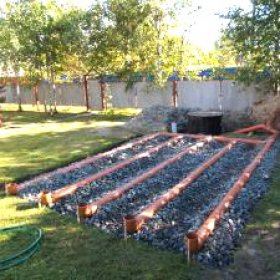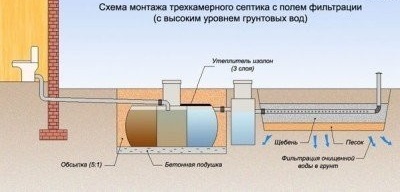Calculation and arrangement of a filtration field for a septic tank + analysis of possible causes of clogging

At dachas and in country houses that are not connected to a centralized sewage system, different models of septic tanks are used to collect and primary clean liquid household waste. The sewage subjected to mechanical and biological treatment at the outlet of the autonomous treatment plant contains a small percentage of contaminants. To finally clean household waste, construct a filtration field for the septic tank. Its area depends on the volume of the treatment plant and the number of sewage treated in a septic tank per day. Drains pass through the bulk filter material and are absorbed into the lower layers of the soil. Subject to the requirements for the construction of such structures, the ecology of the site is not harmed. However, after a certain period of time, it is necessary to replace the filter layer, while the contaminated soil is taken out and a new one is filled up.
The work of the filtration fields is based on the ability of the soil to naturally clean itself. The principle of operation of these treatment facilities is clearly presented in the video:
How should the filtering field be arranged?
The filtration field consists of several trenches in which spray pipes are laid. Previously, a layer of gravel-sand mixture is poured at the bottom of the pit, the thickness of which should be at least one meter.
Then crushed stone is poured over it, in the thickness of which pipes with holes go. The crushed stone layer is covered with geotextile material that protects the laid drainage pipes from clogging. Next, the trenches are covered with soil that was excavated earlier from this site. Rigid perforated sewer or drainage pipes are selected for laying the pipeline in the filtration fields. Domestic wastewater passes through a sand filter, while being cleaned of all remaining impurities.
Important! Effective operation of the structure is possible with its construction in sandy soil, sandy loam or light loam. Moreover, in sandy soils, the load per meter of irrigation pipes is taken at the level of 30 liters per day, and on sandy soils, respectively, 15 l / day. In loams, this value is even smaller, so it is necessary to lengthen the pipes and increase the thickness of the crushed stone layer.

Laying perforated pipes with ventilation risers at the ends is carried out on a layer of rubble and sand
There are several recommendations that must be observed when arranging the filtering field:
- such a structure should not be located in close proximity to the source of drinking water and to a residential building (minimum distance is 15 meters);
- the sand layer, which serves as a filter, should be below the level of soil freezing in the area;
- it is forbidden to lay perforated pipes at a distance of less than a meter to the level of groundwater;
- at the ends of the spray pipes, ventilation risers are mounted to remove unpleasant odors into the atmosphere.
Estimated cost per device
If you arrange a filtration field with your own hands, you can save some of the money on the services of companies that carry out the installation of treatment facilities at a professional level. However, renting special equipment will not be possible. Also, do not save on the quality of purchased materials.
With an approximate calculation of the material costs necessary for installing the filtration field for a septic tank, take into account:
- the amount of land work related to excavation to the depth of freezing of the earth;
- the purchase of crushed stone and sand, as well as their delivery to the place of work;
- purchase of plastic pipes for filtration and their laying;
- acquisition of geotextiles;
- backfilling of a part of soil on top of a geotissue;
- removal from the site of soil remaining after filling the filtration field;
Important! It is advisable to entrust the design and calculation of the filtration field to specialists who, when completing this task, will assess the condition of the soil, the level of groundwater, the volume of daily water flow in the house and other significant factors.

To prevent early siltation of the filtration field, it is necessary to correctly calculate the volume of the septic tank and monitor the health of its operation
Possible causes of clogging of the filtration field
The problem of disruption of the drainage system and the cessation of absorption by the filtering field of water coming from the septic tank can be caused by siltation of the soil. Unfortunately, this process cannot be stopped, but it can be slowed down. The main thing is to prevent poorly treated effluents from entering the filtering field.
A properly selected volume of a septic tank will allow you to cope with the treatment of wastewater generated during the life of not only permanent residents, but also their guests. It is also important to monitor the health of equipment installed in the finished septic tanks and the activity of bacteria responsible for the processing of solid fractions in sewage.
Important! In the case of rapid siltation of the drainage layer of the filtration field, it will be necessary to wash rubble or replace it earlier than planned. Otherwise, the water from the septic tank will have nowhere to go and it will overflow over the edges of the structure. It will be necessary to make the call of the cesspool machine to pump out the septic tank much more often than with the functioning of the filtration field.
In order for the outdoor sewage system to work without problems, it is necessary to select and mount a septic tank with a filtration field using special firms.


